Weird as it may sound, I judge an anime by how many screencaps it nets me. I screencap things on my first run-through an episode or movie, and obsessive-compulsively: if something flashes by my eyes and I miss grabbing the screencap, I will jump backwards in the movie as many times as needed to grab it. Annoying, I know. I wouldn’t want to watch anime with me either!
Much as I’ve been enjoying Star Driver and Kuragehime, the compulsive urge to screencap just hasn’t taken me. I assumed that I’d broken my habit of pausing somehow; that I’d returned to sanity. Then, on a whim, I downloaded Future Boy Conan and realized that I was still the most annoying person on earth to watch anime with.
Seeing as it aired in 1978, Future Boy Conan has aged gracefully; it owes much to Hayao Miyazaki’s direction for this. While the plot may be standard fare 30 years later, a look at the economic climate in Japan during this time is revealing. In 1978, with Japan’s industrial sectors surging and the country on the verge of its infamous Economic Bubble, Conan would have been viewed as dissident to the spirit of the times: how could the growth of industry be anything other than beneficial? In a far-off future of the year 2010(!), Miyazaki paints a picture of a world gone terribly wrong.
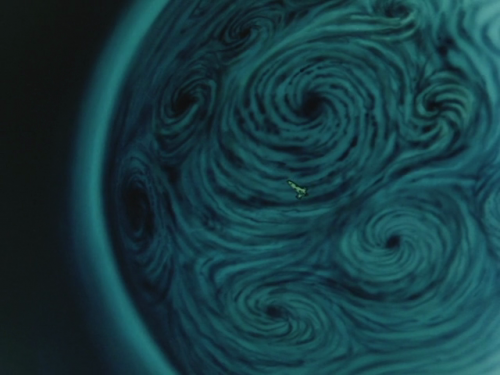
After bombarding each other with ultra-magnetic missiles, the continents sink into the ocean, and the clouds above become a miasmic swirl. Having ruined its only home, what’s left of humanity flees to the stars, only to have their rockets pelted with space debris, sending them crashing back down to earth. We follow Conan, 11 years old, and his grandfather, on Remnant Island, named so for the large rocket ship protruding from its center. Life is peaceful for the two, until a girl named Lana washes up on their shores.
Lana is the granddaughter of the last man alive who knows the ‘secret’ to solar power. He has disappeared from their home, High Harbor. The machine empire at Industria now chases her around the planet, hoping to find her grandfather and sustain their city-oriented way of life via solar energy.
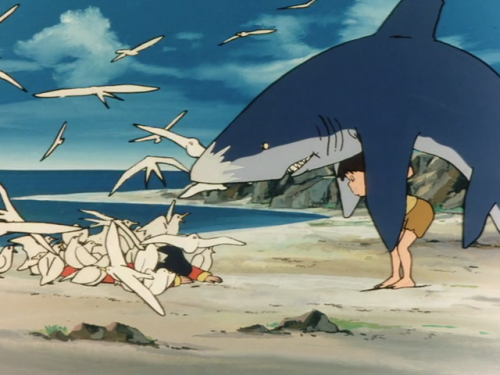

There is a cohesion to Future Boy Conan that isn’t often seen. The animation is pared down and done more in the ‘Disney’ style. Characters are rubbery, and their actions often comical, coinciding with overly arranged music. In this way, it’s very much retro faire; with the heavy overtones of the plot often lightened by Conan carrying, for example, a shark weighing a ton or two, or his plucky friend, Jimsy, getting rip-roaring drunk while stowing away on a ship to the mechanical capital, Industria.
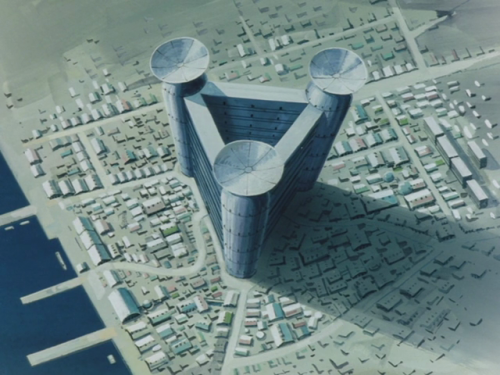
Speaking of Industria, this is where I find Conan’s simplicity of metaphor most interesting. Whereas Miyazaki would later obfuscate his ever-present humans-versus-nature narrative, in Future Boy Conan this binary is boiled down to its most elementary state, and presented in a very pure format to the viewer. Industria is cold and metallic, centered around a nuclear reactor aptly named the Triangle Tower. The aging scientists running the plant are the last of the older generation who started the war. They budget the remaining nuclear energy frugally, using it to fuel machines which turn plastic into bread; occasionally re-routing power from life-essential tasks (such as clothing production) to the chase for Lana.
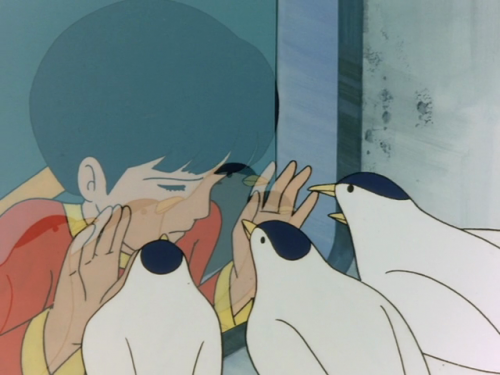
In contrast to Conan’s earthy, rag-tag clothes, and the flowing lines of Lana’s dress the steel feels impenetrable and foreign. Lana, ever surrounded by the birds she can communicate with, is kept in captivity until Conan attempts to free her, only to be quickly re-captured.
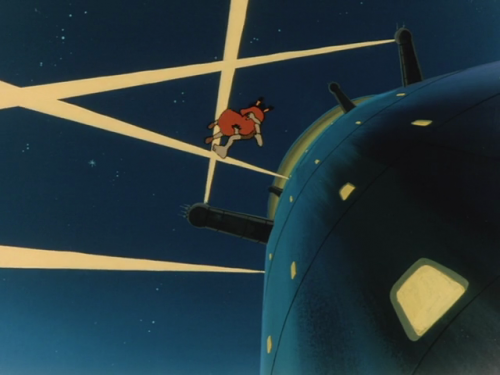
There isn’t much to Future Boy Conan, as much as I’d like to pretend there is. One knows the story as soon as they begin watching it. We know Conan, our slightly un-intelligent yet good-hearted hero, will save the day and somehow overthrow Industria. That’s no mystery to the viewer. What is a mystery is how we’ll arrive at the future Conan finds himself in, however.
Because the dawn is beautiful; Future Boy Conan
13 responses to “Because the dawn is beautiful; Future Boy Conan”
-
I have always wanted to see this series, well after all it is Miyazaki. It looks utterly charming. Sometimes there is nothing wrong with a simple tale.
-
Agreed. I hesitate to use the word “simple” because that implies that its easily digestible and to be taken at face value, which it isn’t. Really, nothing of Miyazaki’s is, though he always makes the effort to make things enjoyable for his viewers irreverent of whether they want to dig deeper or not.
-
-
I empathise with the screencap thing. I must admit, when I’m watching anime, I do think, “oh, I have to capture that for the blog!” but I’m not yet at the point of stopping an episode mid-stream to get it right there and then, rather, I just use this specialised program to create something like 250 screencaps per episode! (This is how I’ve ended up with so many images of The Tatami Galaxy! Some anime is just /too/ beautiful.)
And talking of beautiful anime, this really looks lovely, especially the second-from-bottom image of Lana with the birds, just the way the the seagulls are reflected in the glass. It’s that kind of detail that probably made Miyazaki seem so ahead of his time. Anyway, you’ve convinced me, I’m excited and definitely going to watch this… At some point in the future… I hope… 🙁-
It’s fun to watch something of Miyazaki’s from so early in his career, really. The elements are obviously there, but it’s a touch rough around the edges. Still, he’s a brilliant animator, and this shows through even in his early stuff. Screencaps don’t do Conan justice, for all the discussion we’re having about them 🙂
-
-
My dilemma is always whether to do screencaps or watch shows on the big screen. I usually do screencaps but I always wonder whether I’m missing something compared to the bigger screen.
I wonder if Conan started the trend of post-apocolyptic cities turning to/chasing down young girls to help them recover. A similar situation is present in Now and then, Here and There and in Origin – Spirits of the Past.-
VLC is best for screencapping I find; it saves the screencaps at the video’s original size (pixels) regardless of whether you’re viewing in full-screen or not.
-
-
I take countless screenshots for my blog, and I’ll go back and do it over and over to get the perfect one. The biggest hassle is getting a shot of the person speaking when their mouth is open, especially those girls with tiny mouths. That and quick action scenes.
Bateszi, does that program you mention work under Linux?-
As for me, I try not to take screencaps with text on them in general, unless I’m trying to make a point of something someone’s saying 😉
-
The program I use is called ‘FrameShots’ (http://www.frame-shots.com/) and you can get a free trial of it to see whether or not it works with a Mac 🙂
-
-
I personally almost never stop to take screenshot at first viewing, but I’m very tempted to try out bateszi’s method (saves me the trouble of hunting for screens…).
Future Boy Conana was always on my watch list, but I have to echo bateszi and say sometime…in the future…-
I’m finding it hilarious that everyone’s main comments is on that one little blurb about screencapping :p
-
I think Miyazaki would find it funny, too 😀
-
Guilty as charged!
Also, I haven’t seen the movie, and to write “I want to see this movie now” makes for a lame comment. Well, the one I DID write was pretty lame, anyway. So is this one. Forget I wrote it.
-
-
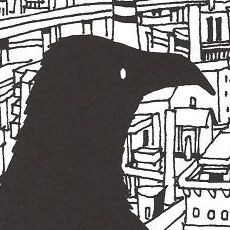
Leave a Reply